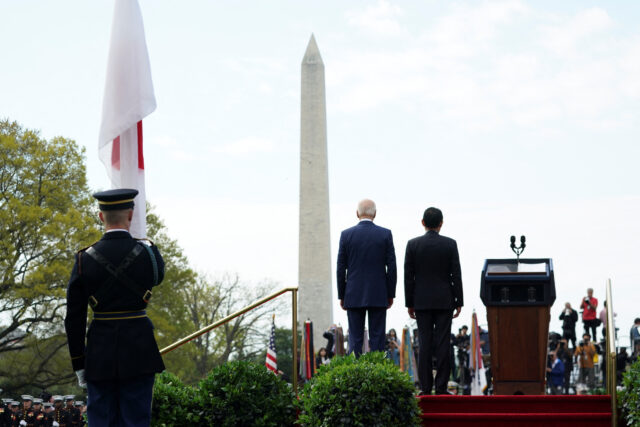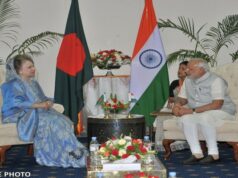WASHINGTON: U.S. President Joe Biden and Japanese Prime Minister Fumio Kishida announced a significant strengthening of their military alliance on Wednesday, pledging increased cooperation and a new missile defense system to address aggressive actions by China and Russia.
“This is the most significant upgrade in our alliance since it was first established,” Biden said at a joint White House news conference with Kishida after about two hours of talks focused on the Indo-Pacific region, Ukraine, and the Gaza conflict.
Kishida emphasized their unified stance, stating, “Unilateral attempts to change the status quo by force or coercion is absolutely unacceptable, wherever it may be.” He warned, “Regarding Russia’s aggression of Ukraine… Ukraine today may be East Asia tomorrow.”
The announcements brought the two former World War Two enemies into their closest collaboration since becoming allies decades ago. Biden said their militaries would operate under a joint command structure, and together with Australia, they would develop a new air missile defence network.
A joint summit statement after the Biden-Kishida meet outlined plans for new military command-and-control frameworks to enable greater interoperability and contingency planning. They also intend to upgrade defence communications networks and network air defence capabilities between the U.S., Australia, and Japan to counter air and missile threats.
The defense plans include establishing a forum to identify areas for co-development and co-production of missiles and maintenance of U.S. warships and aircraft. They will also create a working group for fighter pilot training, including AI and advanced simulators, and co-development and co-production of jet trainers.
Aukus Involvement?
Biden’s meeting with Kishida addressed Japan’s possible involvement in advanced capabilities projects of the AUKUS security pact, formed in 2021 by the U.S., Britain, and Australia to counter China’s growing influence.
The joint statement said the existing AUKUS partners were considering cooperation with Japan in areas like quantum computing, undersea technology, hypersonics, artificial intelligence, and cyber technology.
The statement highlighted “escalatory behavior” by China in the South China Sea. U.S. National Security Adviser Jake Sullivan said on Tuesday that more joint patrols can be expected in the South China Sea after recent drills involving the U.S., Australia, the Philippines, and Japan.
The leaders also announced that Japanese astronauts would participate in NASA moon missions, a joint partnership to accelerate the development and commercialization of nuclear fusion,
The two leaders are also expected to discuss a bullet train project in Texas that would use Japanese technology and investment.
Microsoft announced plans to invest $2.9 billion over two years to expand its cloud and AI infrastructure in Japan. Additionally, four universities will partner on artificial intelligence research, funded by $110 million in private sector investment from companies like NVIDIA, Amazon, Softbank, Microsoft, and others.
The Challenges
The visit may give a political boost to Kishida, whose popularity has waned at home. However, a controversy over the planned $15 billion acquisition of U.S. Steel by Japan’s Nippon Steel, which has faced criticism from Biden and former President Donald Trump, looms over the summit.
Kishida expressed hope that discussions about the deal would “bear fruit” and “cement this win-win relationship.” Biden reiterated his commitment to union workers on the issue.
The leaders aimed to present a united front against China and Russia’s aggressive actions, strengthening their alliance through increased military cooperation, technological partnerships, and economic investments.
(REUTERS)
Also See:
In a career spanning three decades and counting, Ramananda (Ram to his friends) has been the foreign editor of The Telegraph, Outlook Magazine and the New Indian Express. He helped set up rediff.com’s editorial operations in San Jose and New York, helmed sify.com, and was the founder editor of India.com.
His work has featured in national and international publications like the Al Jazeera Centre for Studies, Global Times and Ashahi Shimbun. But his one constant over all these years, he says, has been the attempt to understand rising India’s place in the world.
He can rustle up a mean salad, his oil-less pepper chicken is to die for, and all it takes is some beer and rhythm and blues to rock his soul.
Talk to him about foreign and strategic affairs, media, South Asia, China, and of course India.





